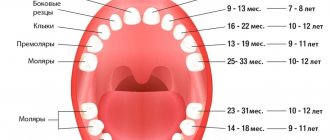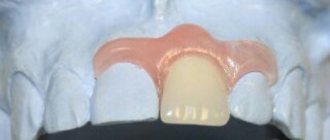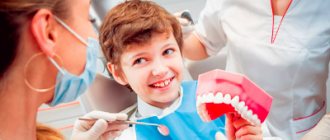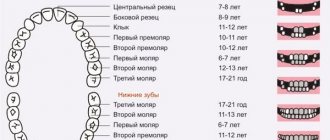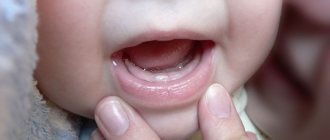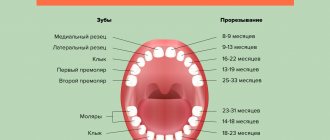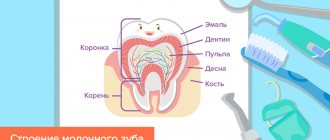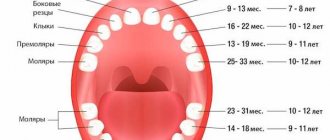Each person goes through the stages of the eruption of the first teeth, the development of milk teeth and their subsequent replacement by permanent ones. Despite their similar appearance and function, temporary and permanent teeth have differences, which we will talk about, at the same time we will consider the timing of the appearance of the main teeth, possible problems with them in the process of their development.
The photo shows a diagram of the structure of human teeth
Sequence of eruption of permanent teeth
Milk teeth have a weak root system, which begins to dissolve by the age of 7. Therefore, in addition to changing incisors and molars, a new bite is formed. Sequence of physiological process:
- from 6-7 years old the first molars appear;
- then, by the age of 7-8 years , the incisors located in the center are replaced;
- by the age of 8-9 years, the lateral primary incisors are renewed with permanent units;
- at 10-12 years of age the relay moves to the first premolars;
- permanent clicks replace milk predecessors closer to 9-11 years ;
- from 10-12 years of age, the second premolars erupt;
- by the age of 13, the second molars are formed;
- Third molars appear between the ages of 16 and 25 ; in some people they never appear.
Names of teeth for easy reference in tables.
Intramaxillary development
The permanent bite is formed on the basis of dental plates, which are formed inside the pits of stratified squamous epithelium. At approximately the 5th month of the child’s embryonic development, an enamel organ appears along the lower edge of the primordial teeth. As mesenchyme grows into it, dental papillae and sacs are formed.
In total, each child has 20 rudiments in two jaws for the development of replacement permanent teeth, 16 of which are present at the time of birth, and the remaining 4 appear at 1-5 years of life. Being in the same alveolus with the milk sacs, after a while they are separated from them by a bone septum and are placed in separate sockets. The dental plates grow in a posterior direction. The main dental tissues are actively developing - dentin, pulp, enamel, as well as blood vessels and nerve fibers.
The order and timing of teething
The table shows the approximate timing of the eruption of permanent teeth. Small differences are allowed for each age group, which is due to the individual characteristics of the body and the influence of external factors.
| Timing for the eruption of permanent units | |
| Tooth name | Child's age |
| On the upper jaw | |
| Center cutter | 7-8 l |
| Lateral incisor | 8-9 l |
| Fang | 11-12 l |
| First premolar | 10-11 l |
| Second premolar | 10-12 l |
| First molar | 6-7 l |
| Second molar | 12-13 l |
| Third molar | 17-25 l |
| On the lower jaw | |
| Center cutter | 6-7 l |
| Lateral incisor | 7-8 l |
| Fang | 9-10 l |
| First premolar | 10-12 l |
| Second premolar | 11-12 l |
| First molar | 6-7 l |
| Second molar | 11-13 l |
| Third molar | 17-25 l |
How long do permanent teeth grow?
There are no exact dates for the growth of permanent teeth; in each case, individual characteristics of the body and hereditary factors play a role.
Time frame for the final formation of the root system of molars:
- incisors located in the center - climb by 10 years;
- lateral incisors - by 10 years;
- fangs - by the age of 13;
- first premolars - emerge by age 12;
- second premolars – 1 to 12 years;
- first molars – by 10 years;
- second molars are cut by the age of 15.
The rate of tooth growth is different for each group. Rapid eruption is observed in the second premolars; in six months they rise by 8 mm. The incisors located in the center rise by 12 mm per year, and the canines grow to 13 mm in two years.
If there is a slight increase over a long period of time, you should see a doctor. Perhaps the child has problems related to the replacement of milk units.
Duration of growth
Typically, children say goodbye to their last temporary teeth at about 12-13 years of age, although the roots of baby teeth dissolve even earlier. By that time, the oral cavity already has molars that are actively growing, and their roots are at different stages of formation.
It is necessary to understand the approximate timing of growth and root formation in case of deviations. It is these indicators that are taken into account when choosing a treatment method.
Experts distinguish two main stages of development of the roots of permanent teeth:
- Stage of unformed apex.
- Unclosed apex stage.
At the first stage, the length of the root becomes maximum, but its walls are parallel to each other. The channel is of sufficient width; it ends in the area of the future apex with a bell. The periodontal gap can be seen only on the sides of the tooth root.
At the next stage, there is a gradual formation of the upper part of the root, the convergence of the root walls and the release of the periodontal fissure, the apical region of which is slightly enlarged.
In what cases may they appear earlier/later and why?
If at least one tooth has grown by the age of one year, there is no reason to worry.
According to statistical data, in modern babies the period of eruption of the first teeth differs slightly from generally accepted normative indicators. White surfaces of the incisors are observed from 8.5 months of age.
Accordingly, the process of replacing dairy units with permanent units is also shifting. Pediatric dentists do not see any problems if by the age of one year the child has at least one tooth , and by the age of three the entire milk group has been formed.
In the complete absence of units, a thorough examination of the baby is carried out to identify provoking factors.
A discrepancy in the timing of teething may be due to a genetic factor or other reasons. Among the main provocateurs of process delays:
- previous infectious diseases;
- disruption of the gastrointestinal tract that occurred over a long period of time;
- problems with the metabolic functions of the body;
- lack of vitamin D (when diagnosing rickets);
- pituitary insufficiency.
It is not only the late teething that is alarming, but also their earlier appearance. Most often this occurs as a result of a disorder of the endocrine system (for example, Albright's syndrome, hyperthyroidism, hypergonadism).
A growing tumor (for example, eosinophilic granuloma) can provoke the eruption of one or a whole group of incisors before the age of six months.
Care instructions
Molars in children require even more careful care than in adults. Frail enamel is much more susceptible to the effects of carious bacteria and the external environment, and the love of sweets and carbonated drinks does not add strength to it. When children develop a permanent bite, parents need to take special control of oral hygiene and diet (at least until the age of 14–15, when the teenager himself begins to realize the importance of dental health). In general, there are no difficulties here: in order to keep children's teeth strong and healthy, you need to follow several basic points.
- Daily hygiene.
Brush your teeth at least twice a day, use dental floss and special rinses. - Proper diet.
Limit your intake of sweets and carbohydrates. - Preventative visits to the dentist at least once every six months.
If necessary, fluoridation and sealing of molars in children (so-called fissure sealing). - Do not forget to wear a protective mouth guard during active games and sports.
Possible problems with deviations from the norm
Complete edentia is a case when teeth are completely absent.
Regardless of the fact that the molars have just appeared or are about to erupt in the mouth of their beloved child, parents should be vigilant, because there are many dental problems. The main issue is the delay in the growth of permanent teeth (a baby tooth has fallen out, but a new one has not appeared).
The reason may lie in a genetic predisposition or edentia, which arose due to a violation of the formation of rudiments during intrauterine development. If there is no way to influence the situation, the child is indicated for prosthetics.
When permanent teeth erupt, another problem may arise – pain. This is most often due to thin, not fully formed enamel, which does not have sufficient mineralization. It is at this stage that the tooth is susceptible to various diseases, in particular caries.
With deep destruction of dental tissues, even more serious diseases develop: pulpitis, periodontitis. Therefore, you cannot ignore a child’s toothache; you need to make an appointment with a pediatric dentist as soon as possible.
At the very beginning of the growth of permanent teeth, other problems can occur:
- loss of a root unit is a signal of serious problems with the child’s health;
- an increase in the level of trauma - the active lifestyle of children during the period of maturation of molars often leads to injury to the incisors and canines, and attempts to chew hard objects end in the breakage of molars and premolars.
Each case requires the intervention of a specialist to eliminate the negative consequences.
Common problems with molars in children
| Problems with molars | How to fix? |
| Molar tooth is loose | A common occurrence with injuries and bruises. To avoid tooth loss, an urgent visit to the dentist and the application of a special splint are necessary, especially if the child’s molar sways when touched. |
| Broken molar tooth | Severe chips may require orthopedic treatment. If a child's front molar has chipped, aesthetic restoration with veneers or crowns may be required. |
| Molar caries | When the first molars erupt, it is important to prevent the occurrence of caries. If this happens, then it is necessary to stop the disease in its infancy, otherwise it will affect the deeper layers of the tooth. |
| A child's molar has fallen out | The most unpleasant thing that can happen. If a child knocks out a molar along with the root, then there is a chance to save it. To do this, you need to place the knocked out tooth back into the oral cavity, saline solution or into a glass of milk and urgently rush to the dentist (you need to do it within 30 - 40 minutes after the injury). If a child’s molar tooth has been removed, then there is only one way out - installing a prosthesis. |
Timing of baby teeth eruption
Babies are born without teeth, although in history there are rare cases of children being born with one or even a pair of erupted units.
As a rule, the first milk teeth appear by 6-8 months - these are the central incisors. Over the course of 2 years, their root system is formed, and from 5 years it begins to dissolve. The process of decay of the roots of milk units is completed after a couple of years.
After the central milk teeth, the lateral incisors erupt (by 8-12 months) . Their roots are absorbed within 2 years, starting at 6 years of age.
In the period from one to one and a half years, the first molars appear. Their root system is formed over 3.5 years. From the seventh year of life, the roots begin to dissolve. The decay process is completely completed after 3 years.
Eruption of fangs occurs from 16 to 20 months of age in babies. It takes 3 years for the roots of milk units to form. Starting from the age of eight, the process of their resorption begins.
The appearance of second molars should be expected at 20-30 months of age. Over the course of 3.5 years, the root system is formed, which begins to dissolve from the age of seven.
About nutrition
With the appearance of the first teeth, the process of feeding the baby begins to change. With the first tooth, the sucking reflex is replaced by the need to gnaw and bite, so liquid and soft food alone is no longer enough. At each feeding, give your child a piece of dried bread, a slice of cucumber or a carrot that is not completely soft, or a quarter of an apple without peel or seeds. Chewing improves blood supply to the gums, trains and strengthens emerging teeth, and improves nutrition for those that are about to erupt. The consistency of the food should begin to change from puree-like to heterogeneous, with small and then larger pieces. This “enlargement” of food is inherent in industrial canned food for children of different ages.
The ability to chew well is one of the signs of the well-being of the central nervous system. This skill is not easy for children with neurological problems, but it is very important for them. The habit of chewing is the key not only to healthy digestion, but also to clear articulation and intelligible speech. Babies who have “porridge in their mouth” in infancy preferred porridge and purees to solid foods.
With the appearance of the first teeth, it is necessary to abandon pacifiers, so it is better not to accustom the child to them at all. The fact is that nipples form an incorrect bite in a child, “turning out” the teeth. The same applies to the habit of thumb sucking, and, at an older age, chewing on a pen or pencil. Baby teeth deteriorate very quickly, as they have a more porous structure than permanent teeth, and can rot completely within a year or two.
